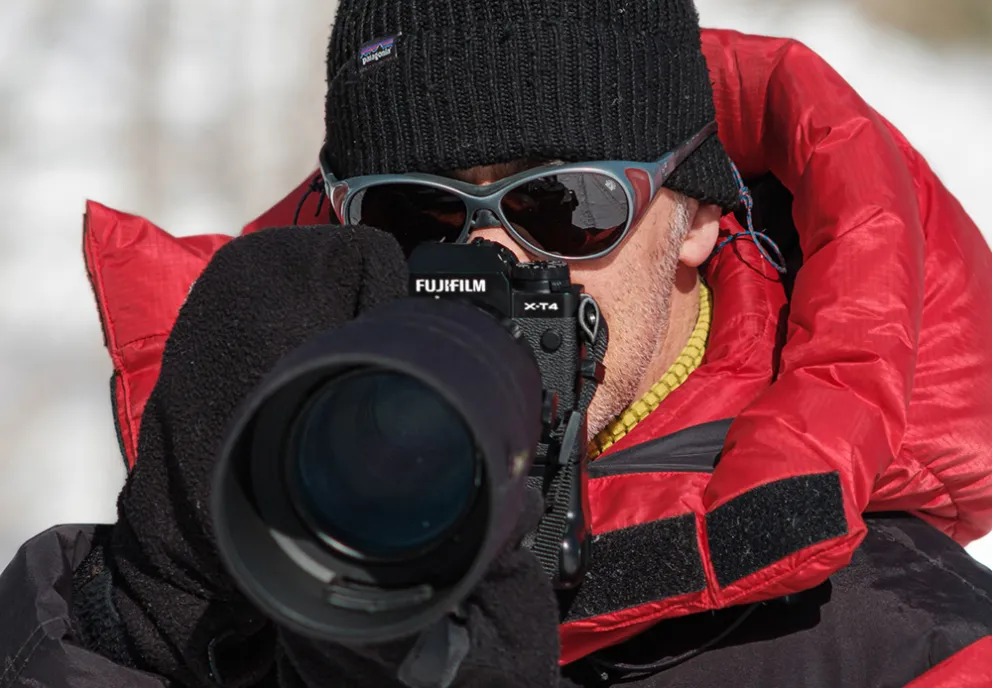
UPAA Blog 2020-21 #17 - 3/1/21 (text and photos by Michel Caron)
The UPAA blog is beginning a monthlong series of articles/reviews of the latest generation of mirrorless cameras from Fuji, Nikon, Canon and Sony. A similar series ran in 2018.
Michel Caron is photographer/videographer (photographe vidéaste) at Université de Sherbrooke in the province of Quebec, Canada. He has been in that position since 2007 and joined UPAA in 2019. He gives a look at the recent Fuji flagship XT-4, along with a recollection of his journey in the mirrorless world--Mon voyage dans le monde sans miroir.
A couple months ago, I bought the Fuji flagship X series camera, the X-T4 and realized it was my 13th mirrorless Fuji camera! As many are switching now to mirrorless, maybe it can be interesting to know why I still think I made a good decision in December 2013 to go mirrorless exclusively. Here is why…
History
I learned photography looking at the humanist photographers like Cartier-Bresson and Erwitt. They were recording everyday life of humans and most were using a Leica and a 50mm lens. When I began taking my own pictures, I rapidly got my first Leica M3 and a couple lenses. The rest of my history as a pro photographer is probably similar to many of UPAA members. I sold the Leicas so I could get a more versatile kit with different focal lengths and pro bodies. It was followed by back-and-forth Nikon and Canon gear. In some ways, my art became dependent of my tools…
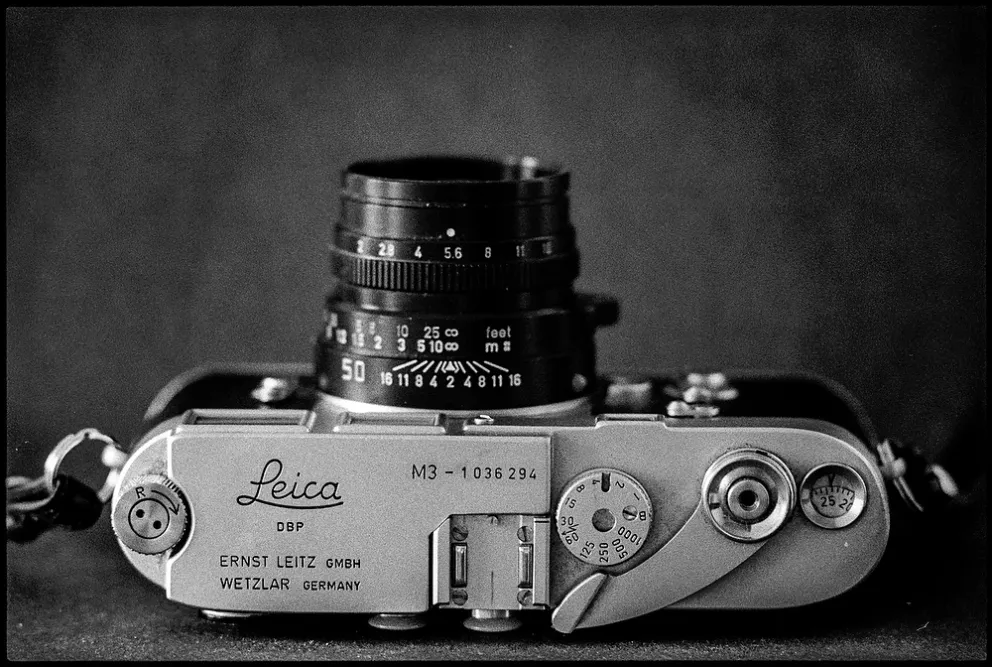
One of my Leica M3s with the Summicron 50mm. Probably shot with the other M3 with the Summicron 90mm. I sold all my Leica gear when I began to do more commercial photo assignments.
Why the Fuji X series in 2013?
First, the feeling and compactness of the X100 and X-Pro1. Every photographer who started working in the 35mm film era can grab a Fuji X-Pro1 (or an X-T4) and shoot without even looking at any menu. Speed and aperture dials are exactly where they used to be…since 1925 with the Leica 1! The X-Pro1 became my new Leica but at 1/10 the cost with AF in bonus. With the first pictures, art was coming back in my head and my photographs. The mirrorless ability to show me the pictures before shooting was interesting. My approach to my photography hadn’t change for years: I want to get the best “negatives” I can get and work the post-process like I use to work in the darkroom. I’m used to pre-visualize the rendering I want for a picture, whenever it’s a colored saturated landscape or an intimate low-contrast black & white image. For that, I use RAW only for all my pictures so I adjust the Fuji color settings in a way that they would be as close to the RAW file as possible in terms of colors, saturation and contrast. When I look in the electronic viewfinder, I know for sure that the same details and contrasts are in the RAW file.
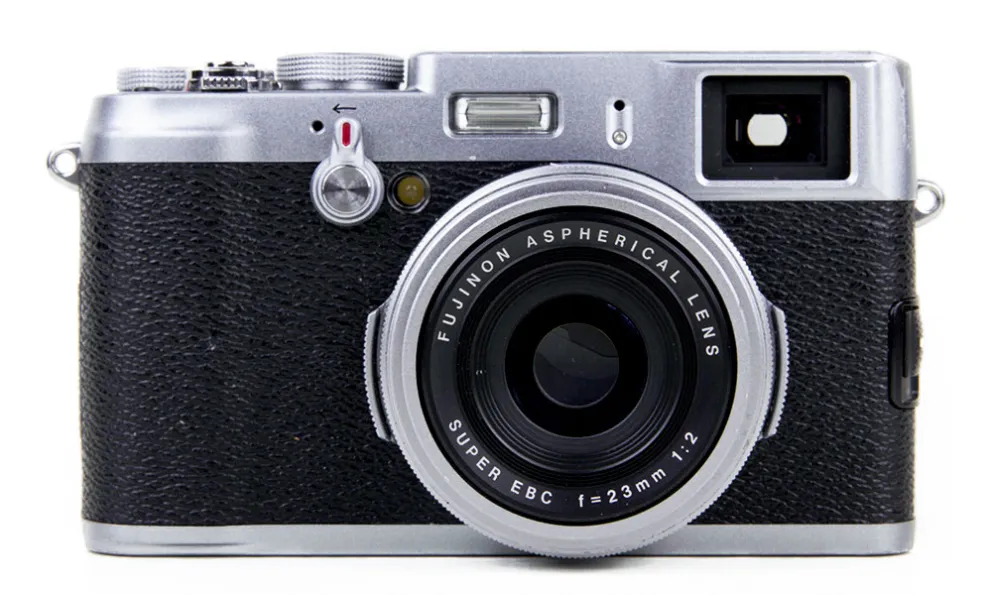
(Fujifilm product image) The original Fuji X100, the first of the X-series. First unveiled in September 2010.
Since I see the RAW before taking the picture, I nearly stopped using the backscreen after taking pictures. There’s a lot of talking about the Fuji JPEG in-camera rendering but for me, it has never been important. In the rare occasions I must send a file from the field, I create in-camera a JPEG and send it to my iPhone via the worst app ever created! If there’s one technology Fuji need to improve, it’s officially their phone app! Few months ago, the updated it…and added French to the languages so now I can struggle to connect in French, my first language. Electronic viewfinder wasn’t perfect in 2013 but after a couple weeks, I was used to it and the advantages of pre-visualization surpasses easily all the little inconveniences. Another benefit of the EVF is the possibility to review an image in the EVF instead of the backscreen. As I need glasses to verify the details on the backscreen, I prefer to review my images in the EVF which is adjusted to my sight.
Going mirrorless only in 2013 wasn’t a move many pros were willing to take. The university gear was still a mix of Nikon D700 for stills and a Panasonic P2 video camera for videos. At the time, Fuji only had 5 or 6 lenses available. I gradually used more and more my Fuji gear for stills assignments. The D700 was a good camera but the benefits of the mirrorless were higher in every aspect except AF.
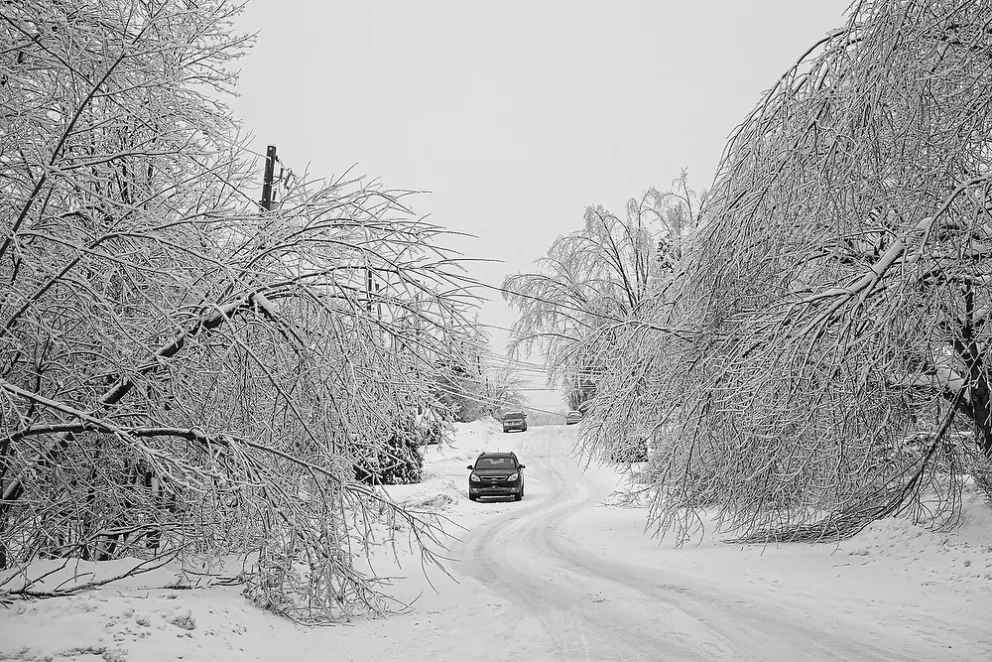
One of my first pictures with a mirrorless camera. X-Pro1 with the 35mm f1.4 lens. Every year in Québec we got a couple of ice storms but that December 2013 one was big in my area with a lot of large trees fallen down in the old part of the town.
What tools I really need
My University budgets for new gear are always extremely strict. Forget the annual budget, it’s more like a ten-year ultra-special budget, authorized by the highest finance authority. So, since day one as staff photographer in August 2007, I always mixed my personal and work camera gear. I now have two Fuji X-H1 at work with 3 pro zooms. My personal gear consists of the X-T4 (Fuji X flagship), wide aperture primes (including an old Nikon 300mm 2.8 AIS), the 100-400mm zoom I use for wildlife and a little Fuji X100F (poor man's Leica…) that follows me everywhere.
As I now shoot as much video than photo, a few years ago I convinced my boss to switch to Fuji and buy two X-H1 which was the most advanced Fuji body at the time. Why two? Because in video, two angles is the minimum and working with two identical bodies is so easier during the shoot and in post-production. I can even transfer every personal setting from one body to the other. The X-H1 was the first Fuji camera with IBIS (in body image stabilization). I must admit that for the kind of video work I do, I already have a gimbal stabilizer. The IBIS of the X-H1 help for short sequences. In my opinion, IBIS brings more benefits to photo than video. The possibility to stabilize any lens, even my Nikon 300mm 2.8 manual focus, is a game changer. Depending on the subjects in front of the camera, IBIS is probably the most major advancement in cameras since autofocus.

IBIS and stabilized lens allows a slow hand-held speed of 1/4 sec without worry. Fuji X-H1 + 10-24mm f4
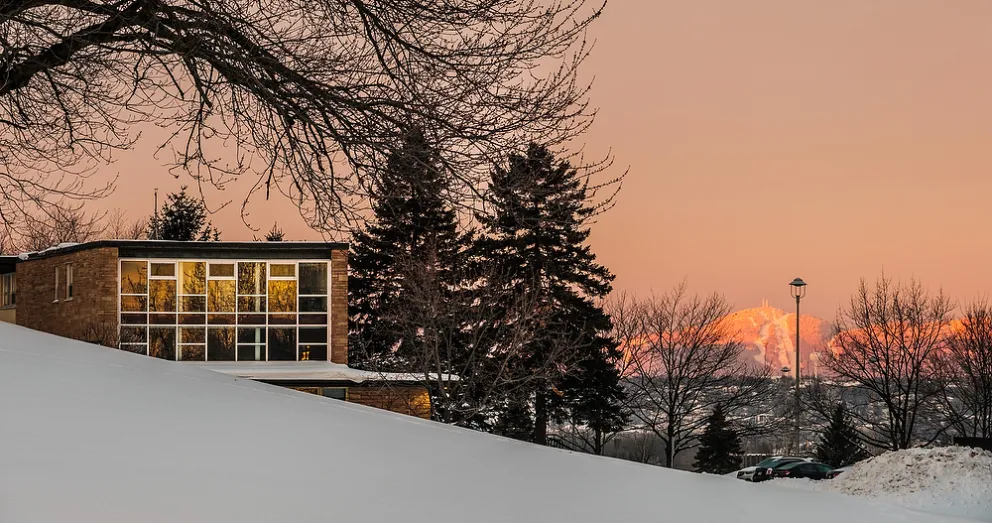
On-campus student housing with Mount Orford ski area in the background. IBIS with lens stabilization let me use 1/10 sec shutter speed for this unplanned shot taken on campus at a moment I didn’t have my tripod with me. I could have used a higher ISO but the IBIS let me use an ISO and aperture that made the highest quality file. Fuji X-H1 + 50-140mm. 1/10sec @f9 @ iso250
Talking about AF, Fuji cameras AF systems, even the X-T4, are not the fastest money can buy when it’s time to catch the eye of an eagle in flight or an NFL running back going for a touchdown. But it’s fast enough for almost everything else! Every photographer's needs are different. I often shoot in manual focus or pre-focus to a designated spot. And the Fuji's EVF is so bright and sharp that manual focusing is much easier than with a DSLR. For this blog, I looked at the December MIC competition and I evaluate that out of 52 winning pics, 33 were absolutely possible with manual focusing as they were posed and/or in staged, mostly static situations. By that, I’m not saying that AF is silly or that the Fuji X-T4 is terrible at AF but I know by experience that the Nikon D6 or Canon 1Dx are a world apart from the AF performance of the X-T4 and it’s why pro sports photographers are going to be the last users of pro DSLRs. Looking at the new Sony a1, it’s evident that new mirrorless cameras are becoming faster and faster in every aspect so I will not be surprised if the D6 and 1DxIII are the legacy brands' last pro DSLRs…
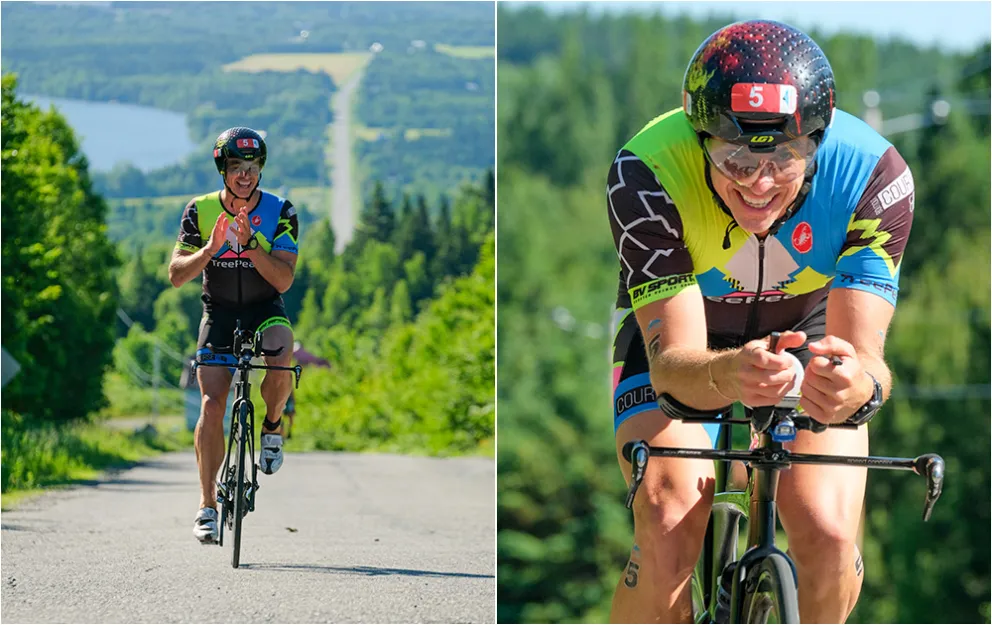
A competitor during CanadaMan 2019. One of the hardest triathlons in the world. Same distances as Ironman but with an enormous amount of climb on the bike and a trail marathon going up to a high peak for the finish. Even if the X-H1 hasn’t the fastest AF money can buy, coupled with the right Fuji lens, it can keep up with a lot of action. Fuji X-H1 + 50-140mm 2.8
Another thing I need for my tools is the ability to get good quality pictures AND video. With the Fuji X-H1 and X-T4, it’s simple and really fast going from one to the other. More and more often, my colleagues expect me to bring back photos and videos from the same assignments. It’s not what I prefer as the thinking isn’t the same but it’s my work and having the right tools make all the difference. On the X-T4, the still/movie dial is just beside the shutter so I can change it with a finger without stopping to look through the EVF. The kind of details that count.
Finally, I need cameras that let me work in quiet places without disturbing. We have one of the best music schools in Quebec and I think those musicians can hear the noise of a feather falling on the ground! In this regard, all the Fuji cameras have quiet mechanical shutters while the X-H1 and X-T4 are nearly silent. That lets me take hundreds of frames during a shoot without disturbing anyone. Electronic shutter is also an upgrade over the DSLR. Distortions are annoying and banding can appear depending of the light source, so verification on the backscreen is necessary. The X-H1 is good but when I shoot birds in flight, I can see some banding on the tip of the wings. The X-T4 is supposed to be better but birds are in low number around here as the temperature is below freezing all the winter. I will verify that next spring! In this regard, every new body I bought was better than the predecessor and I will use it with more confidence with the X-T4.
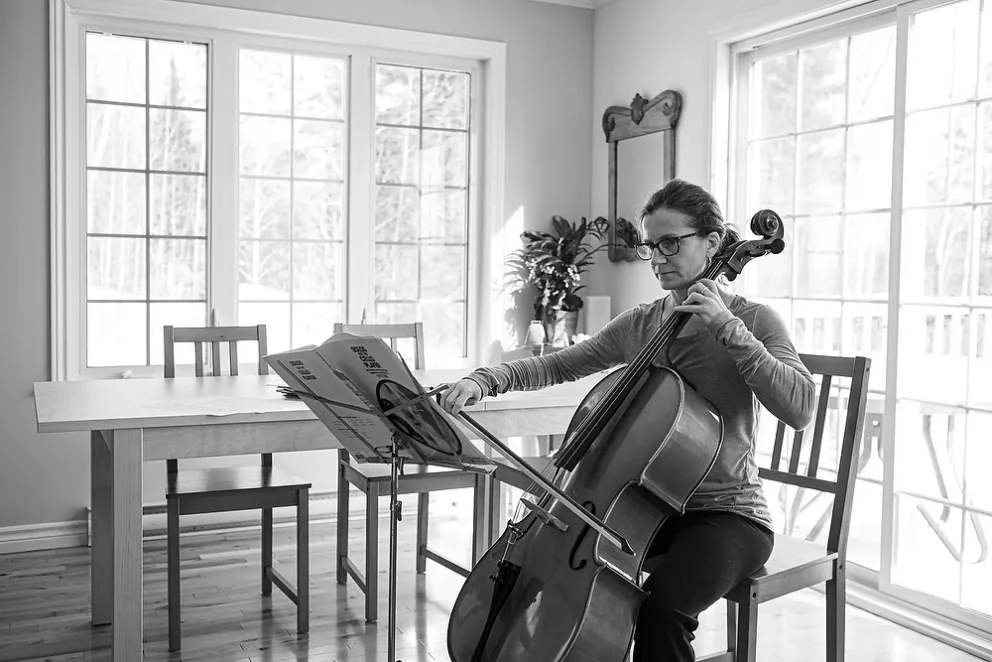
Cello practice. Since using mirrorless bodies, I never had a single time I've been asked to stop shooting because of the noise, even in classical concerts or practices. X-H1 and X-T4 both have really quiet mechanical shutters + completely silent electronic shutters. The X-100 series has a completely silent leaf shutter with flash synchro up to 1/2000sec. X-Pro1 + 23mm 1.4
Why Fuji in 2021
When I decided to upgrade to the Fuji X-T4 last December, I was looking to upgrade from X-H1 mostly because of 3 improvement: better AF system, a bigger battery and some better video settings. I’m really happy with the upgrade except for one thing: the screen. The X-H1 screen was perfect for ground or overhead shooting while the X-T4 screen is aimed at vloggers and selfies addicts. It takes me a couple seconds more to place it right and can’t use it efficiently with an L-bracket for horizontal and vertical tripod attachment.

A student demonstration against climate change in the pre-COVID masking/distancing days of 2019. The high-angle photo was made with the Fuji XH-1 and 10-24mm f4 zoom on a monopod using the XH-1's tilting screen for framing.
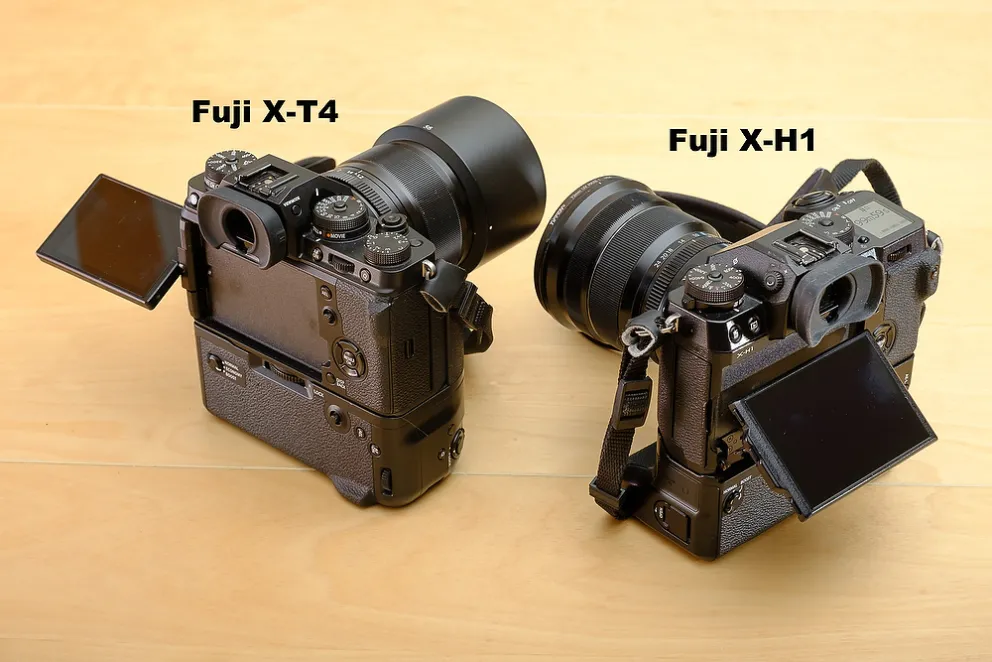
When needed for ground level or overhead point of view, the X-T4 screen need to be turned to the left then tilted. It makes it longer to use in a hurry and riskier to break or get tangled with the neck strap. Probably designed for selfies and vloggers.
About batteries…Mirrorless tech needs a lot of power and I live in a place where the temperature goes as low as minus 25F! I am also a mountaineer with major expeditions like Denali (3 times), Aconcagua and countless Mount Washington ice climb, ski or hiking trips. When I heard that the X-T4 had a bigger battery, I immediately researched that feature and decided to upgrade. The new battery nearly doubles the number of frames and is much more resistant to the cold. I didn’t buy the battery grip at first because it was too expensive and didn’t sold including the batteries. Instead, I had bought 2 spare batteries and eventually got the grip on E-Bay for half the normal price. Contrary to the X-H1 grip, the X-T4 grip didn’t bring any feature or boost mode, not even a charging plug.
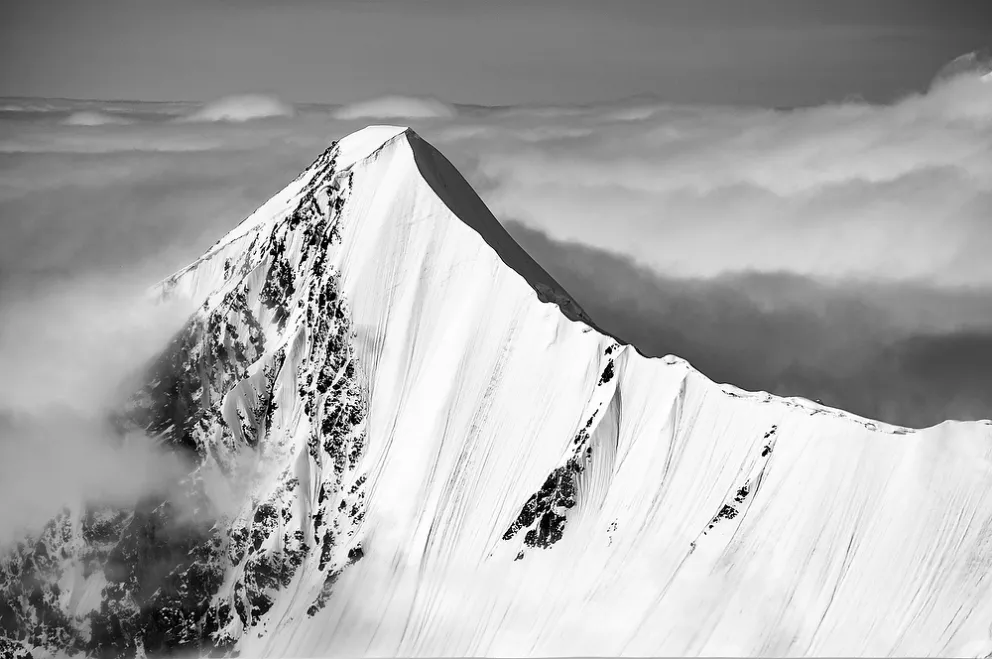

Expeditions to Denali
One important factor for professional photography is a good lens selection. When people ask me about the large number of lenses I bring to some assignments, I ask them if they will put their confidence in a dentist if he only has 1 pair of pliers on his little desk… Here the mirrorless shines and Fuji in particular excels. About quality/price, I can’t find better options than in the Fuji lenses offering. I know that comparing full frame and APS-C lenses isn’t fair for some persons, but my argument is that they serve the same purpose: creating a high-quality image.

Michel earned a first place MIC award with this image made with the Fuji 16-55mm f2.8 zoom.
Most Fuji lenses sell for 50 to 75% the price of their full frame Nikon or Canon equivalent. For example, my Fuji 56mm 1.2 sells for half the price of a Canon 85mm 1.2 which is the equivalent in full frame format. I don’t doubt that the Canon must be a fantastic lens but I never used one and I know is that the Fuji 56 is one of the sharpest lens I've owned in my 30+ years career and the build quality is on par with the Leica Summilux and Summicron lenses I had long time ago. Since I switched to the mirrorless Fuji, I have built a complete system containing every focal length from fisheye to 400mm, including fast AF zooms, large aperture primes and a macro lens…without having to get a mortgage on my house ;-). And, as most now know, we can easily adapt other brands and/or vintage lenses on these cameras. In the past years, I have used the manual focus Nikon 55mm 2.8 micro, 300mm 2.8, 400mm 3.5 and 600mm f4 with excellent results. Like with the full frame market, some third-party companies also offer great options. I love my Rokinon fisheye and 12mm f2! They are manual lenses but who needs AF with a fisheye?
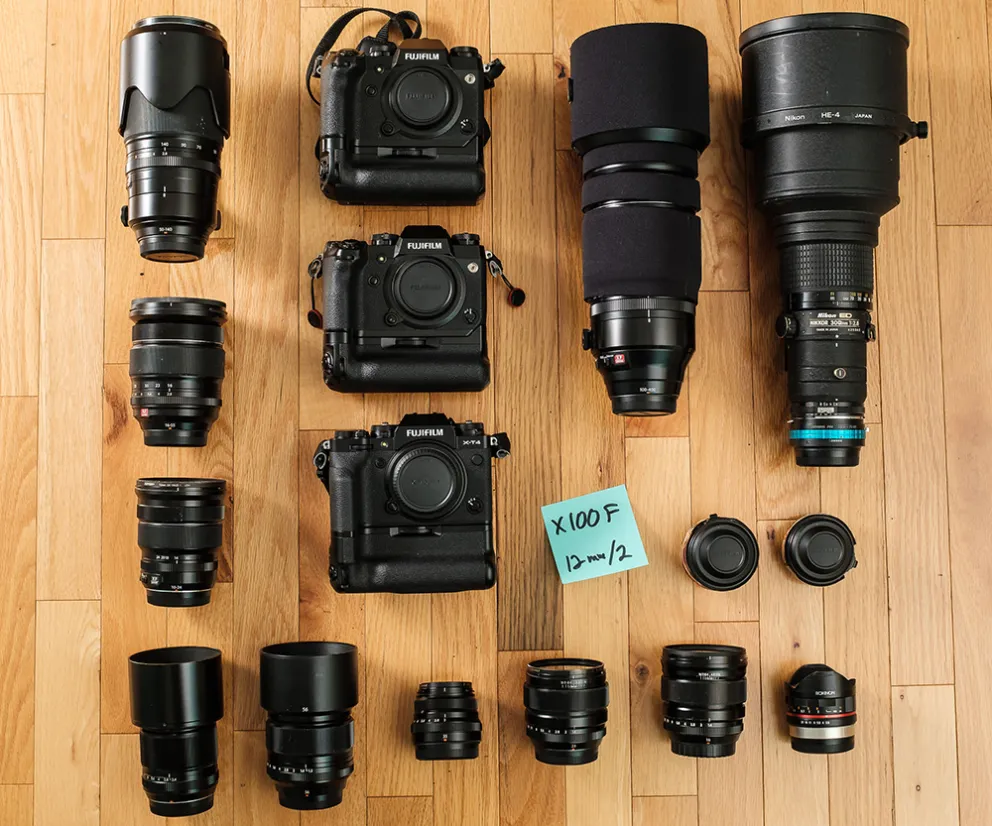
Current tools! X-H1 (2), X-T4, X100F (used for the picture), 8mm 2.8 Rokinon fisheye, 12mm 2 Rokinon (loaned to my son), 16mm 1.4, 23mm 1.4, 35mm 2, 56mm 1.2, 60mm 2.4 macro, 10-24mm 4, 16-55mm 2.8, 50-140mm 2.8, 100-400mm 4.5-5.6, 300mm 2.8 Nikon (with Fotodiox adapter), 1.4x & 2x Fuji teleconverters
Another reason I love my Fuji’s comes from a bit of bad luck I had last summer. As I was using a homemade camera raft for taking pictures of wildlife from my kayak, the raft turned upside down and my X-H1 with the 100-400mm and 1.4x went underwater for a couple of seconds. Condensation was horrible and some water was inside the lens. I knew that removing the battery was the first thing to do and rushed to my house for a week of rice containers, crying with rage and even putting the lens in the oven (with careful monitoring). I saved the body, the lens, the teleconverter and the battery grip! After one week, everything was working just fine! I always looked at the “weather resistant” markings as marketing stuff but I now admit that the WR on my Fuji lenses and bodies actually mean something!
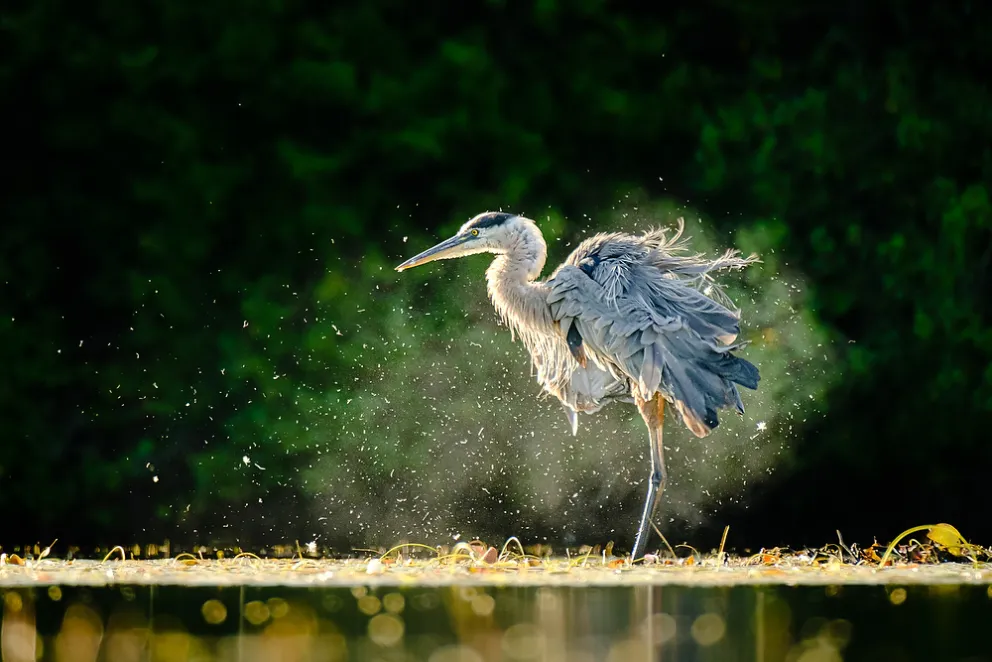
Minutes before dropping the camera, I got this picture of a Great heron using the little camera raft. Fuji X-H1 + 100-400mm + 1.4x
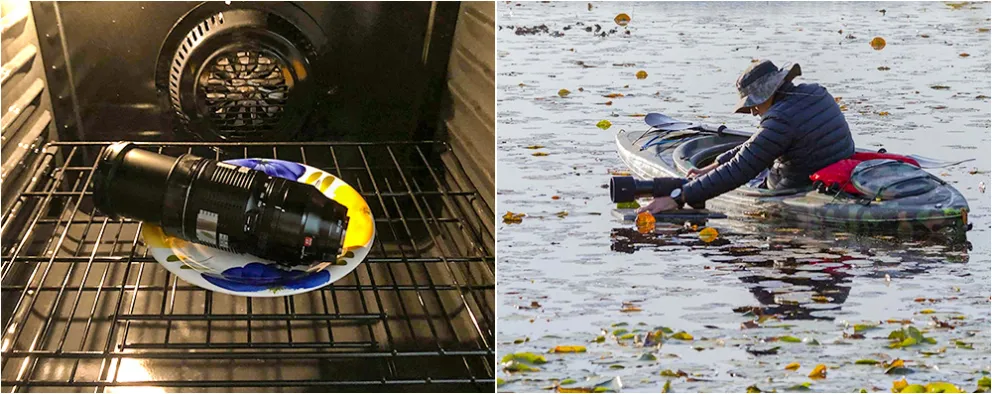
Left: The lens was completely opaque from condensation even after 3 days in a container with rice. A friend convince me to use a more aggressive treatment. I removed the rubber parts and put the lens in the pre-heat oven and monitored the condensation decrease every 5 minutes. The oven operation last a couple hours…but it works great! Right: The home made camera raft I used with the X-H1 + 100-400mm. It floats beside me and my kayak. This was prototype 2…Next spring I will make one larger ;-)
Mirrorless cameras brought many innovations and one of them is called “pre-shot ES” in the Fuji X-T4. It lets me take pictures before I press the shutter! It’s a functionality that was present in the video world for some time. With the electronic shutter on, the camera starts to register frames at the moment the shutter is half pressed. When fully pressed, it writes on the card 10 frames prior to the effective fully pressed shutter. All that at 20 fps or even 30 fps if cropped lightly. We all know excellent photographers who can anticipate sports or wildlife action, but this function can help even the best out there!
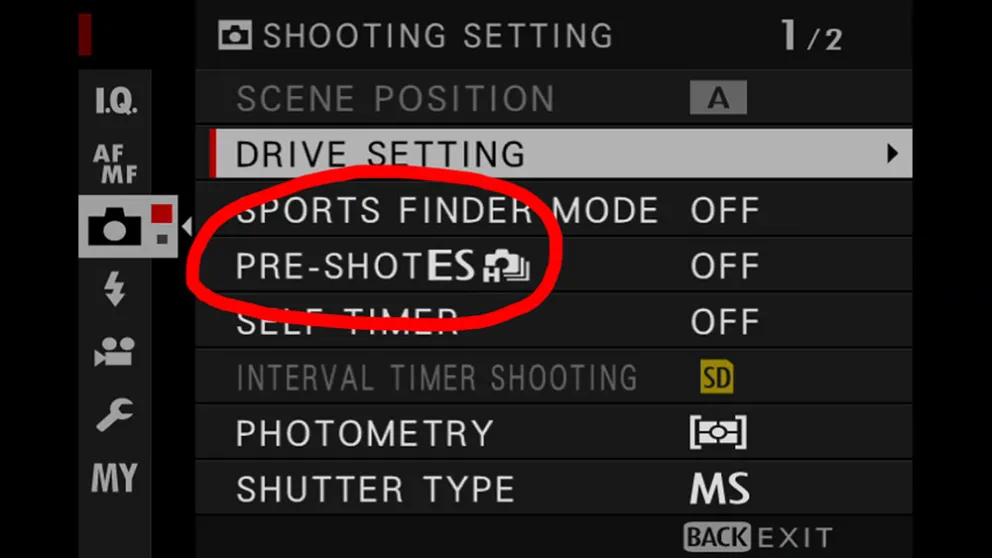
(Fujifilm product image) Pre-Shot ES, first available on the XT-3.
Recently, as Nikon, Canon and Sony are now offering really good mirrorless cameras, I asked myself if I was to continue with Fuji and the answer is yes. To my knowledge, Fuji is the only manufacturer to offer a pro capable camera system with bodies and lenses having classical controls position and AF. The only thing I still struggle with is the focal lengths numbers of APS-C sensor size! I am so used to the analog and digital full frame focal lengths that a 23mm is a weird, unnatural way to describe my 35mm framing equivalent. It’s probably similar to asking my American friends to follow a recipe using grams instead of ounces or doing some carpentry using centimeters ;-)
(Editor's note: Michel adds: "The XH-1 and XT-4 both have voice memo!")
___________________________________________________________
"I'm not familiar with the metric system." -Patton Oswalt | Merci d'avoir lu le blog de l'UPAA. Le rédacteur du blog Matt Cashore est très drôle. mcashore@nd.edu. Suivez l'UPAA sur Instagram!